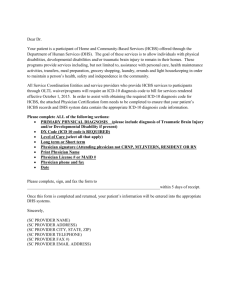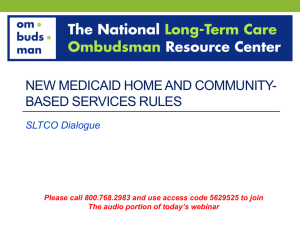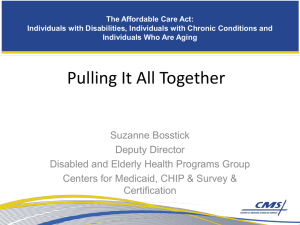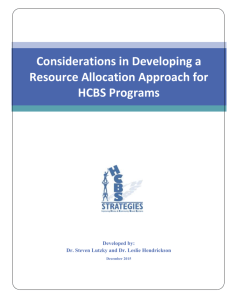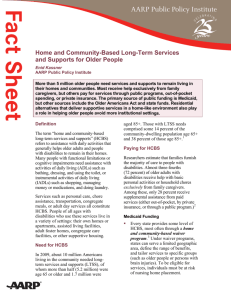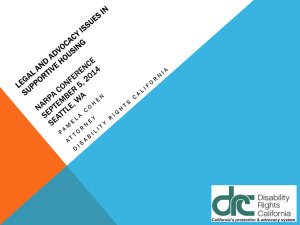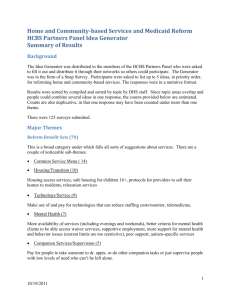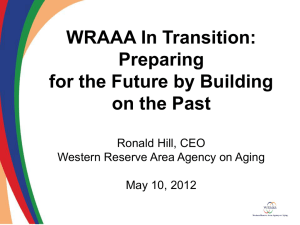Measuring the Quality of Home- and Community
advertisement
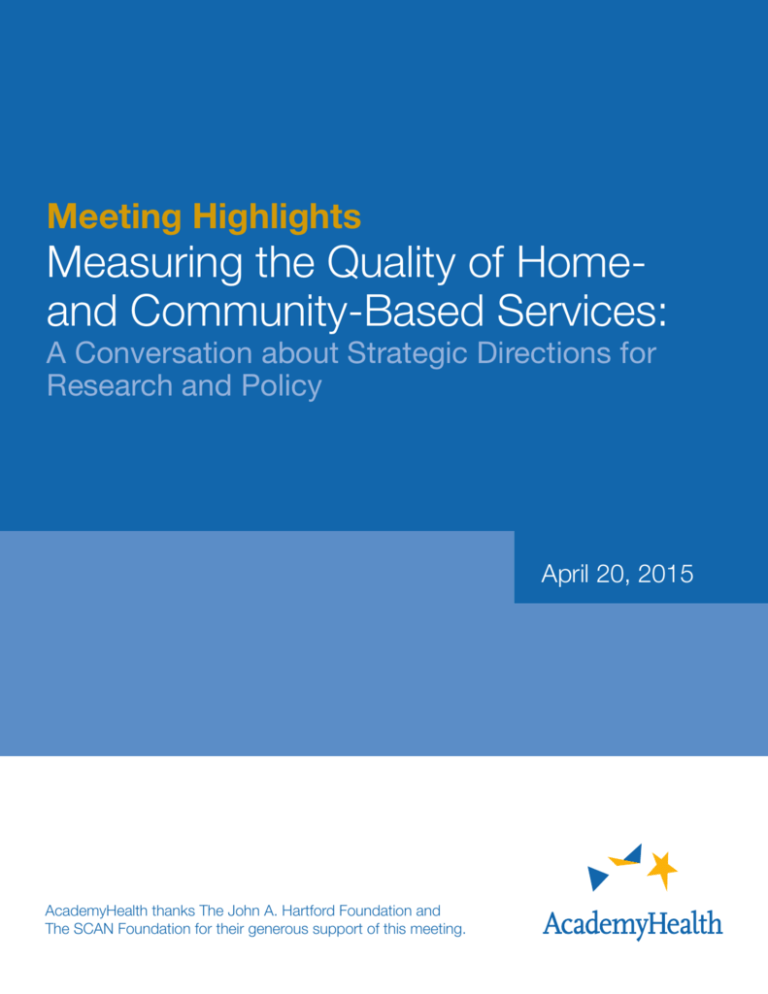
Meeting Highlights Measuring the Quality of Homeand Community-Based Services: A Conversation about Strategic Directions for Research and Policy April 20, 2015 AcademyHealth thanks The John A. Hartford Foundation and The SCAN Foundation for their generous support of this meeting. Measuring the Quality of Home- and Community-Based Services Overview Millions of Americans receive long-term services and supports in their homes and in community settings. Indeed, the vast majority of older adults receiving supportive services, roughly 80 percent, live in private homes; only 20 percent reside in institutional settings—either nursing homes or other residential care settings.1 Most of this home and community-based care (HCBS)—which includes a wide array of personal care services and other forms of assistance—is provided by family members and friends. But HCBS also includes formal services that are paid both privately and publicly. In 2011, roughly $58 billion was spent on community-based care.2 Despite the importance of the services and the vulnerability of the populations served, the size of the programs providing HCBS, and the growing demand for that care, relatively little is known about the quality of those services, who is receiving them, who is providing them, or what efforts might be needed to improve the quality of HCBS. On February 11, 2015, AcademyHealth convened a group of researchers, policymakers, and practitioners to discuss what is known today about the quality of HCBS, how to define and measure HCBS quality, and how measures might be used to improve quality. Three experts in policy, practice, and research related to long-term services and supports kicked off the session and set the stage for a lively discussion with the invited participants, all of whom represented diverse, multidisciplinary perspectives. (Bios for the presenters and a list of the experts who attended are at the end of this brief.) During the half-day dialogue, the participants grappled with substantial conceptual and practical challenges for measurement. They noted that we are a long way from widely and consistently implemented quality measures for HCBS, despite decades of state reporting to the Centers for Medicare and Medicaid Services (CMS) on HCBS quality, and despite the numerous efforts to catalogue existing and proposed measures. Among the challenges for quality measurement is the incredible diversity of the population needing and using services. Addressing the quality concerns of the diverse HCBS population will be a tremendous challenge. Another key takeaway was that federal leadership will be needed for HCBS quality measurement to move forward. While there has been private sector leadership in the development of health care quality measures – with medical professional associations and private purchasers acting as measure stewards – HCBS stakeholders lack the resources to advance measure development on their own. The participants identified several areas for additional conceptual development and empirical research, including the following: 1.Defining HCBS services and outcomes. More research is needed on the relationship between HCBS services and outcomes, with a focus on standardization regarding what the services are and what we expect these services to do. This research will help develop transferable standards across programs and providers. 2. Meeting the needs of family caregivers. More attention is needed on how HCBS meets goals pertaining to family caregivers, such as involving them in plans of care, communications with caregivers, and improving caregiver wellbeing. 3. The uses of HCBS quality measures. Greater conceptual development is needed on how HCBS quality measures will be used to improve the quality of services. This brief provides highlights of the remarks from the presenters and of the conversation that followed. It is intended to advance the conversation and help frame future discussions of HCBS quality. Presentations A 15-Year Retrospective on Medicaid HCBS Quality Presenter: Anita Yuskauskas, PhD Anita Yuskauskas started the conversation by providing some historical perspective on the Medicaid HCBS program. She identified contextual issues and tensions that are important for understanding the current and evolving approach to quality measurement and quality improvement in the program. Key Points •The state-centric Medicaid HCBS program results in substantial variation of programs and service definitions. • Quality is hard to measure when services lack standard definitions. • There remains a lack of consistency in quality assurance activities across states. • Momentum for quality measurement is increasing. • The 1915c waiver application provides an opportunity to build quality into the program. Dr. Yuskauskas noted that the HCBS Section 1915c waiver program, which came into being in 1981, created a flexible and decentralized program that was responsive to local needs. The variation in waiver programs across and within states, however, creates substantial challenges when it comes to conceptualizing and measuring quality on a national level. The Medicaid HCBS program is state-centric. Consequently, there is a lack of consistency across states in the definitions of the services being provided. Specifically, the units of service and scope of benefits vary widely. This variation creates challenges when it comes to measuring quality—and especially for understanding how strategies for quality improvement might affect outcomes. Over time, according to Dr. Yuskauskas, the Medicaid HCBS program grew into an “alphabet soup of different authorities,” adding more complexity to HCBS and creating a “Tower of Babel” relative to standardization. 2 Measuring the Quality of Home- and Community-Based Services As the Medicaid HCBS program grew in size, there was a growing need to address quality. Dr. Yuskauskas explained that CMS policy focused on continuous quality improvement (CQI) paired with quality assurance (QA) activities. Prior to 2000, the entire approach to quality in the HCBS program was a checklist approach that focused on process and look-behind evaluations. and the components of quality that we should be measuring. There are also continuing tensions related to the appropriate roles for the federal government, states, and managed care plans in monitoring and enforcing quality standards. In 2003, the Government Accountability Office (GAO) issued a highly critical report on the lack of federal oversight of HCBS quality in Medicaid HCBS programs.3 The GAO criticized CMS for failing to provide guidance to the states or to its Regional Offices. In response to the report, Dr. Yuskauskas explained, CMS issued an Interim Procedural Guidance “that provided a quick way to start an HCBS quality program.” Dr. Yuskauskas noted that the 1915c program remained the reference point for quality activities, though some services were provided under state plans and under other waiver authorities (e.g., Section 1115 waivers). The guidance required states to provide evidence on quality assurances to CMS, but “without a clear framework for how quality should be measured and assured, States continued to provide inconsistent information regarding the assurances to CMS.” Presenter: Barbara Gage, PhD Barbara Gage tied Dr. Yuskauskas’s discussion of the Medicaid HCBS program to the larger context of quality measurement. Dr. Gage pointed to a number of developments in the larger quality measurement endeavor that create an opportunity for HCBS quality measures to be “brought to the table” in as strong a position as measures of clinical quality. Dr. Gage cited: (1) the Triple Aim as an important framework for advancing HCBS quality measurement, and (2) advances in the science of quality measurement. Today, Dr. Yuskauskas suggested, several developments are creating momentum for quality measurement, but a variety of challenges remain. The development of a new application for 1915c waivers created an opportunity to build quality into the application, and therefore the design of the program. Around 2008, for example, the automated waiver application became more specific regarding quality oversight and included requirements related to how states should survey their waiver populations to provide evidence-based quality data that was representative of the entire waiver. The application also included requirements for analyzing quality assurance data and presenting the information to CMS. Despite these more specific requirements, the review process is still not automated and CMS does not collect the underlying data, but receives only summary reports from states. There remains a lack of consistency in quality assurance across states. communities, and (3) affordable care – provides a framework for measuring quality in HCBS programs. Dr. Yuskauskas expressed some hope that greater consistency of focus and meaningful approaches to quality measurement could be developed in the Medicaid program. She pointed to increasing focus on integrated and person-centered care, to self-direction, and to the role of health information technology as opportunities to develop shared concepts and to develop better ways of talking about quality in these diverse HCBS programs. A variety of tensions continue to characterize the development of quality measures in the Medicaid HCBS program. Dr. Yuskauskas pointed to the tension between the QA processes and QI, which many stakeholders suggest should be separate approaches. She also noted that quality measure development is hampered by a lack of standards, or evidence-based practices, in HCBS. She maintained that although everyone agrees that outcomes should be measured, there is still a long way to go in terms of understanding, in a standardized way, the interventions and subsequent outcomes of HCBS, Current Directions in Quality Measurement Key Points • The focus on person-centered care is an opportunity to improve HCBS quality measurement. • The Triple Aim – (1) better care, (2) healthy people, healthy • National Quality Strategy priorities (for achieving the Triple Aim) that relate to HCBS include: engaging the person and family in care, including family caregivers as part of a team, and promoting effective coordination of care. • Advances in the scientific measurement of quality provide a tremendous opportunity to level the playing field when talking about social and medical services. Dr. Gage began her remarks by talking about her recent work to standardize the various patient-assessment tools in use across Medicare post-acute care settings – including the skilled nursing facility Minimum Data Set (MDS), inpatient rehabilitation facility Patient Assessment Instrument (IRF-PAI), and the home health care Outcome and Assessment Information Set (OASIS). Dr. Gage suggested that this work has lessons for HCBS quality, in terms of thinking about what we need to define (to understand the service needs of the frail or disabled adults who need HCBS) and how to do that work in a relatively standardized way. According to Dr. Gage, states need flexibility, but to the extent that different programs are measuring the same concepts, there needs to be consistency across programs in order to move toward scientific and reliable ways to measure quality. How to take the work on HCBS quality measurement forward? Dr. Gage suggested that one of the most important aspects of the ACA is its focus on person-centered care. Post-ACA, there is a focus on coordinating the whole range of services that are needed to improve health—both medical and social services. Person-centered care and a focus on meeting individual goals has been a long standing 3 Measuring the Quality of Home- and Community-Based Services issue in HCBS. The medical community is starting to think about that as well. The two communities should come together to talk about what’s need to achieve person-centered health care and health goals. The ACA calls for the development of a National Quality Strategy – a strategy that is not specific to Medicare or Medicaid, but that seeks to achieve better care, healthy people, and healthy communities through targeted local, state, and national efforts. Dr. Gage observed that a number of the six priorities (developed by the Agency for Health Care Research and Quality (AHRQ) to achieve the Triple Aim are related to medical care, including priorities related to reducing harm from health care services and to addressing the leading causes of mortality. But the priorities are not entirely medical and a number of them are relevant to HCBS, including: engaging person and family in care; including family caregivers as part of a team, and promoting effective coordination of care. Dr. Gage argues that the medical-social distinction should fade as care is increasingly organized to be person centered. Much of the groundwork has been laid, with particularly innovative plans and delivery systems focusing on the coordination of medical resources and community resources. (She identified the Commonwealth Care Alliance led by Bob Master in Massachusetts as an example of a system designed to address the whole needs of people with medical and long-term care needs.) A number of activities have been sponsored to bring the community aging networks, for example, together with Accountable Care Organizations and other plans and delivery systems to talk about these collaborations to structure services around the needs of patients and families. Next, Dr. Gage turned to a discussion of the opportunity afforded by improvements in the science of quality measurement. The National Quality Forum (NQF) is an initiative to develop scientific standards, and Dr. Gage suggested that NQF has made a big contribution in the establishment of science around quality metrics. NQF has a number of initiatives that are potentially related to HCBS quality, including panels to address post-acute care, person-centered care, care coordination, and care for people with Alzheimer’s disease and related dementias. Nevertheless, she identified a number of domains that are not being measured today that she believes should be measured. Based on the assessment tools we have today, Dr. Gage explained, we can measure medical status, physical function, cognitive status, social support factors, and experiences of care, but there are still a lot of areas that need attention. Dr. Gage referenced the gaps identified in the final report of the NQF Panel on dual eligibles, which highlighted gaps in measures of HCBS quality.4 The gaps identified by the NQF dual eligible panel are related to many of the goals of HCBS including goal setting, shared decision making, systems to support medical and social services, self- determination, community integration, and optimal function (Exhibit 1). Exhibit 1 National Quality Forum “High Priority Gaps in Measures” for Dual Eligible Beneficiaries4 • Goal-directed, person-centered care planning and implementation • Shared decisionmaking • Systems to coordinate acute care, long-term services and supports, and nonmedical community resources • Beneficiary sense of control/autonomy/self-determination • Psychosocial needs • Community integration/inclusion and participation • Optimal functioning (e.g., improving when possible, maintaining, managing decline) Dr. Gage concluded that although there is much work to be done, the Triple Aim is a useful framework for moving HCBS quality measures forward, that the science of quality measurement is improving, and that there is a tremendous opportunity to level the playing field when talking about social and medical services. There are a variety of challenges related to variation across states in services, definitions, and measures, but important progress is being made as the distinction between medical and social services fades, and the conversation becomes more focused on people and their needs. Measuring HCBS Quality: A (former) Practitioner’s Viewpoint Presenter: Bruce C. Vladeck, Ph.D. Bruce Vladeck raised a critical perspective on measurement and raised a cautionary note about the expected uses of the measures. Key Points • Because HCBS has been regarded as intrinsically good, assessing quality has not been a priority. • Efforts to improve nursing home quality through public reporting have fallen short. • For HCBS quality, we have to worry about what the right definitions and measures are. • There is even more work to do, conceptually, on how those measures are going to be employed to improve the quality of care. • The use of quality measures in Medicare pay-for-performance has not been effective at improving quality. • Things that do seem to be effective at improving quality have to do with organizational structures, leadership, value structures, and decision-making processes. 4 Measuring the Quality of Home- and Community-Based Services Dr. Vladeck began his remarks with a reflection on the recent history of efforts to measure and improve the quality of nursing home care. He reflected on his experience, as HCFA Administrator, rolling out new nursing home survey and certification rules on July 1, 1996. The survey and certification regulations were the last piece of the Federal Nursing Home Reform Act (OBRA 1987) to be put in place. They were rolled out under enormous political pressures and in a Presidential election year. Dr. Vladeck explained: “Despite the industry’s resistance to the rules, for the one to three years after the rules were implemented, they made a difference in eliminating the most severe problems in some proportion of nursing homes in the United States, with some improvement along some dimensions of care.” But, he explained, “as best I can tell, the quality of care in U.S. nursing homes has deteriorated very significantly since that time.” Vladeck contended that “We are in about the same shape relative to the quality of nursing home care in 2015 as in 1982. Nursing home residents today, moreover, are significantly sicker and more dependent than they were.” He pointed to several explanations for the quality trend. First, he observed, “there has been no change in the requirements or the measurement.” But perhaps the most notable fact is that states’ budgets for nursing home survey and certification have not increased in nominal terms in 20 years. Most states, he said, are “barely complying with the minimum requirements and in some locations— Iowa and Los Angeles, for example—they are out of compliance.” These states and localities, Vladeck suggested, do not have the staff to do the basic surveys. In addition, the ability of states to enforce sanctions against nursing homes with serious problems is diminished. “Everyone has been so preoccupied with the idea that we are going to do away with nursing homes,” he observed, “that concerns about the quality of care provided there no longer receive the attention they deserve.” At the same time, Dr. Vladeck explained, “efforts to improve nursing home quality for Medicare patients through public quality reporting have also crashed. CMS has been forced to acknowledge that the Medicare Nursing Home Compare tool, which is supposed to help people make informed choices of nursing home care, has been based on unreliable information and erroneously scaled.” For Vladeck, this history of nursing home quality relates to how we think about quality in HCBS. “Everyone decided in the late 1970s and early 1980s that HCBS is intrinsically good,” he said. He went on to point out that enrollment caps were the major concern with the management of the 1915c HCBS waiver program in 1990s. The number of people enrolled for services was limited by state budgetary calculations and, in many states, fell far short of meeting total demand; assessing the quality of the services provided in home and community settings was not a policy priority.When we think about improving quality, Dr. Vladeck said, we have to worry about not just what the right definitions and measures are, but we also have to think about how those measures are going to be employed to actually improve the quality of care. Here, Dr. Vladeck suggested, we are way behind conceptually. Using quality measures in payment, Vladeck suggested, “has been a failure.” Vladeck opined: “Medicare’s approach to value-based payment has been, in effect, a way of randomly taking money away from certain hospitals and giving it to others. Readmissions penalties have forced hospitals to start complying with the Joint Commission discharge planning standards that have been on the books for 20 years and not enforced. Those penalties have had a punitive economic effect on hospitals that take care of poor people and people of color.” Dr. Vladeck observed that “the notion that we now know how to make quality happen is inconsistent with what we know from pay for performance: it doesn’t seem to be terribly effective at improving quality.” Other things, by contrast, that do seem to be effective at improving quality have to do with organizational structures, leadership, value structures, and decision-making processes. Said Vladeck, “We don’t talk so much about these things because of who dominates policy discussions and who is not a part of those discussions.” He closed with an appeal for a more pragmatic (and less economistic) approach, saying, “I hope that when we start talking about HCBS, and when quantitative, econometric methods don’t work for helping us understand what is happening in home and community services, we broaden our notion of what quality is how to improve it. If we don’t, we are not going to have improved the lives of beneficiaries.” Discussion The role of HCBS in the changing health care landscape Throughout the morning’s discussion participants offered a variety of perspectives on the need for quality measures, and reflected on the role of HCBS in the changing health care landscape. There was discussion of how accountable care organizations, integrated health plans, and patient-centered medical homes, for example, increasingly are trying to understand community-based services: what they are, who provides them, and what they can do for patients and families. Though these health care providers are trying to improve quality for beneficiaries, they have long way to go to understand and coordinate those services and supports. It’s not easy for the medical community to know “what’s out there.” We are a long way from where we want to be in HCBS quality measurement With these delivery system changes as a backdrop, the discussants noted that we’re not very far along in the development and implementation of quality measures for HCBS. There is some level of agreement on some of the kinds of things we should be measuring. But there is very little consensus on what might be most important to measure today and for what purpose. HCBS poses distinct challenges. Quality measures should be defined relative to the ultimate goals of or outcomes of LTSS. These goals could be to optimize functional outcomes, to assure independence, dignity, and quality of life, and to relieve caregiver burden, for example. To get to good measures, we have a fair distance to go in understanding what 5 Measuring the Quality of Home- and Community-Based Services matters to frail elderly adults and other persons with disabilities, and the outcomes the services are designed to achieve. But while outcome measures are needed, process and structure measures are also needed to fully conceptualize quality of care. The program evaluators in the room provided a reality check on where we are today. They described the constraints they face in evaluating LTSS programs and especially the quality of HCBS while also noting the limitations of Medicaid administrative data, and the challenges of getting encounter data from managed care plans. Among the challenges for measuring quality in HCBS is the immense variability in the populations served, and the needs-based system serving them, including the types of services that are needed and used. To reduce some of this complexity, a taxonomy of the services provided under Medicaid HCBS programs has been developed by CMS. The taxonomy organizes a broad range of HCBS services into an orderly classification of services. Nevertheless, the tremendous variation in HCBS and how it is delivered remain impediments to quality measurement. Related to this discussion of the current limitations of administrative data sources, a number of people in the group suggested that the data for HCBS quality measurement needs to come from administrative sources. Efforts to collect patient-reported experiences and outcomes through survey instruments were viewed as a key part of quality measurement, but could not be the sole source of information for calculating measures due to cost and feasibility constraints. What is high quality HCBS and how can it be measured? Meeting participants felt a variety of aspects of quality (quality domains) can be and should be measured. They identified quality domains for HCBS including: quality of life, personal autonomy and control, community engagement, satisfaction with services, person-centered care planning, and the competency of providers, including their interpersonal communication skills. Within these larger domains, there are many subdomains or standards. Although a number of efforts have been made to catalog the measures that are in use or that have been proposed, and to determine where the gaps in measurement are, there is still a long way to go in developing measures and having them consistently applied in programs. The territory is vast and prioritization efforts will be needed. Even things which seem to enjoy general support, like person-centered care planning, are difficult to measure. There is a wide variety of processes that are said to provide person centered care planning and challenges in assessing whether the resulting plans meet some standard for person-centeredness. As a result, in many case, these gaps remain “stubborn.” Framing HCBS quality at the community level In terms of how to frame the quality measurement agenda, Joanne Lynn made the case for reportable measures at the community level – at the county level, for example – since the “natural organization and service delivery for frail elderly population is the geographic community.” People are tied to community for trained aides and capable doctors, for example. According to Lynn, we measure quality of programs or we measure quality at the state level, but we have skipped the most important organizational level which is “something like a county.” She maintained that our responsibility is for all of the people in a community, not just those who are eligible for a certain set of program services. She also described the need for “serious, longitudinal comprehensive care planning” and called for “building systems that can regularly generate care plans.” In theory, these care plans could be a data source for managing at the community level, providing, in aggregate, details on services maintained or discontinued in the face of diminishing resources. In this way, the care plan could become a system management tool. Unfortunately, there isn’t a social structure that allows that question to be framed. Part of the reason we’re so far from HCBS quality measures is that HCBS is very different from medical care With regard to ACOs and managed care and the need to understand and measure HCBS, there was some discussion of the tendency for these medical systems to want to bring experience from medical sector and apply it to HCBS. These entities may find it frustrating that the medical framework does not easily apply itself in this context. There was discussion throughout the morning of the fact that HCBS is different from medical care in ways that matter for measurement. Medical care is characterized by professional norms, professional education, and bodies of knowledge. When thinking about how to improve the quality of medical care, many assume that we have board-certified physicians and other health professionals who can be reasonably expected to work according to tested and accepted standards. In nursing home settings, there are some expectations for training standards. Nursing home regulations include training requirements for certified nurse aides. In HCBS, there isn’t even agreement on whether providers should come under Fair Labor Standards Act. Moreover, each state defines provider qualifications for each uniquely defined service. In HCBS, “there is no standardization of anything.” HCBS was characterized as being in a “pre-paradigmatic phase.” We don’t really understand fully what the services are or who is providing them, so the challenge is how to take into account that unstandardized “state of the art” in HCBS. There was considerable agreement expressed in the meeting that there needs to be more attention to research and to the development of evidence-based practice standards in HCBS. What quality measurement might reasonably be expected to do is to facilitate the development of transferable standards across programs and communities. 6 Measuring the Quality of Home- and Community-Based Services How will HCBS quality measures be used? A number of perspectives were shared on how measures of HCBS quality might be used and by whom. Participants described the need for measures that consumers could use to select providers, but they also expressed a desire for measures that could be used -by researchers and regulators -- to evaluate program performance. Participants expressed the view that measures are needed to meet practical, program needs. The “train has left the station” on delivery system reforms that have the potential to reshape HCBS –without agreement on standardized measures that might be used to assess changes in the quality of the services provided. The view was also expressed that some caution is warranted because of the potential for measures to be misused. Throughout the conversation, there was agreement that more attention is needed to how measures will be used. What’s needed to move forward? Efforts by medical providers and plans to connect with community-based LTSS was regarded as a positive development, but the discussion often returned to the “power divide” between medical and social services. While physicians can order expensive medical procedures with a relatively free hand, there is limited coverage for the supportive and social services that are needed by frail elders and their family caregivers in the community. This same divide is apparent in what gets measured. There are, at best, limited pockets of funding for HCBS measure development and a lack of stewards for those measures (organizations capable of providing the infrastructure and support for scientific measures). Although the meeting was not intended to produce a concrete set of steps that should be taken next to conceptualize and measure HCBS quality, the group identified a number of challenges and opportunities for advancing efforts to understand what quality is, how it can be measured, and the purposes for which measures are needed. Assessing and improving quality involves costs, and several participants made the point that progress will not occur without federal investment and leadership by the Department of Health and Human Services. Unlike medical care, where private purchasers and their stakeholder groups have invested in the development of health care quality measures, leadership on the HCBS measures will have to come from the public purchasers. States, meanwhile, cannot develop and consistently implement standardized measures without federal leadership. The advocacy groups that represent LTSS clients and potential consumers or provider communities, for example, do not have the resources and expertise to undertake the measure development. Conclusion For a number of reasons, including a presumption that HCBS is necessarily higher quality care than nursing home care, research on outcomes and other information to judge the quality of HCBS is lacking. As the population ages and the demand for these services increases, more resources will be needed. More resources also will be needed to improve state and federal oversight of HCBS programs, to inform policy development, and to improve consumer understanding of HCBS and the quality of HCBS providers in their communities. The discussion at this meeting highlighted a number of conceptual and practical challenges to HCBS quality measurement, but there was great enthusiasm for a robust research agenda to define HCBS quality, to assess the current status of HCBS quality, and to understand how measures can be used to monitor and improve quality. This brief was prepared by Ellen O’Brien, Senior Fellow, AcademyHealth. Endnotes 1.Older adults are defined as those age 65 and older. Congressional Budget Office, Rising Demand for Long-Term Services and Supports for Elderly People, June 2013. http://www.cbo.gov/sites/default/files/cbofiles/attachments/44363-LTC.pdf 2.CBO, 2013, p. 9. Expenditures on community-based care were less than half of what was spent on institutional care ($134 billion in 2011). 3.Government Accountability Office, Federal Oversight of Growing Medicaid Home and Community-Based Waivers Should Be Strengthened, June 2003, www.gao.gov/ new.items/d03576.pdf 4.National Quality Forum, Input on Quality Measures for Dual Eligible Populations, August 2014. www.qualityforum.org/Publications/2014/08/2014_Input_on_Quality_Measures_for_Dual_Eligible_Beneficiaries.aspx 7 Measuring the Quality of Home- and Community-Based Services Agenda The Quality of Home- and Community-Based Services: A Conversation about Strategic Directions for Research and Policy Wednesday, February 11, 2015 Renaissance Washington Hotel, 999 9th St NW, Washington, DC 20001 Room: Grand Ballroom North With Funding From The John A. Hartford Foundation and The SCAN Foundation 8:00-8:30 a.m. Continental Breakfast 8:30-8:45 a.m. Welcome and Purpose of the Meeting Lisa Simpson, Ellen O’Brien, Margo Edmunds 8:45-9:30 a.m. Where We’ve Been, Where We Are Now, and What We Need to be Thinking About for the Future Anita Yuskauskas, Penn State, and Beth Jackson, Truven Health Analytics, A 15-Year Retrospective on Medicaid HCBS Quality Barbara Gage, Brookings Institution, Current Directions in Quality Measurement Bruce Vladeck, Nexera, Inc., Measuring HCBS Quality: A (former) Practitioner’s Viewpoint 9:30-10:00 a.m. Discussion: Quality Measures and Measurement What do we measure well? Where are the best models for implementing quality measurement? What are the practical challenges to measuring quality in HCBS? 10:00-10:15 a.m. Break 10:15-10:45 a.m. Discussion: What Measures Do We Need? What are the key gap areas? How should we address the gaps? What would it take to develop a core set of person-centered measures? 10:45-11:15 a.m. Discussion: How Should Measures Be Used? What kinds of systems promote accountability? How do we know what we should we pay for? 11:15-11:55 a.m. Priority Setting: How to Build the Evidence Base for Change in Payment Policy 11:55 a.m. Closing Remarks Margo Edmunds Noon Adjourn 8 Measuring the Quality of Home- and Community-Based Services Participants Gretchen Alkema, PhD The SCAN Foundation Julie Bershadsky, PhD Human Services Research Institute Jessica Briefer French, MHSA National Committee for Quality Assurance Joe Caldwell, PhD National Council on Aging Kirstin Colello, MPP Congressional Research Service Camille Dobson, MPA National Association of States United for Aging and Disabilities (NASUAD) Pamela Doty, PhD Office of the Assistant Secretary for Planning and Evaluation, HHS Toby Edelman, M.Ed., JD Center for Medicare Advocacy Margo Edmunds, PhD AcademyHealth Marcus Escobedo, MPA The John A. Hartford Foundation Judy Feder, PhD Urban Institute Barbara Gage, PhD, MPA The Brookings Institution John Haaga, PhD National Institute on Aging Carol Irvin, PhD Mathematica Policy Research Steve Kaye, PhD University of California, San Francisco Harriet Komisar, PhD AARP Public Policy Institute Sarah Lash, MS National Quality Forum Bruce Leff, MD Johns Hopkins University Joanne Lynn, MD Altarum Abby Marquand, MPH Paraprofessional Healthcare Institute Anne Montgomery, MS Altarum & NASI Ellen O’Brien, PhD AcademyHealth Nora O’Brien-Suric, PhD The John A. Hartford Foundation D.E.B. Potter, MS Office of the Assistant Secretary for Planning and Evaluation, HHS Christine Ritchie, MD, MSPH University of California, San Francisco Brenda Spillman, PhD Urban Institute Bruce Vladeck, PhD Nexera, Inc. Timothy Waidmann, PhD Urban Institute Kelsey Walter, MSW NASUAD Jennifer Wolff, PhD Johns Hopkins University Anita Yuskauskas, PhD Penn State Lehigh Valley 9 Measuring the Quality of Home- and Community-Based Services Meeting Facilitator Margo Edmunds, PhD, is Vice President, Evidence Generation and Translation at AcademyHealth. Dr. Edmunds leads the AcademyHealth portfolios on population health, information infrastructure, delivery system reform, and translating research into policy and practice. She has more than twenty years’ experience implementing and evaluating health and health care policy initiatives for federal and state government, foundations, associations, and other clients and has directed three national studies on health care coverage, access, and financing for the Institute of Medicine. Dr. Edmunds is a former Adjunct Associate Professor of Health Policy and Management at the Johns Hopkins Bloomberg School of Public Health and teaches emergency and risk communication in the graduate communications program at Johns Hopkins Krieger School. She currently chairs the Public Policy Committee for the American Medical Informatics Association (AMIA), is an Associate Editor for Applied Clinical Informatics, and frequently speaks at national conferences and meetings. She is an elected member of the National Academy of Social Insurance and a Fellow and former Board member of the Society of Behavioral Medicine. Dr. Edmunds began her health care career as a member of the affiliate staff at Johns Hopkins Hospital and completed a Research and Clinical Fellowship at the Johns Hopkins School of Medicine. Presenters Anita Yuskauskas, PhD presently works for Pennsylvania State University (PSU) Lehigh Valley campus as the Coordinator for the Health Policy and Administration Program. From 2003 to 2014, she worked at the Centers for Medicare and Medicaid Services, where she served as the Technical Director for Quality in Medicaid Home and Community-based Services (HCBS). While there she was the Agency lead for quality in HCBS and participated on numerous cross-federal quality measurement teams. Yuskauskas also did policy development work relative to self-directed service delivery models and served as a liaison for HCBS policy issues related to American Indian-Alaska native tribes. Preceding her federal tenure, Yuskauskas served as Division Chief in Hawaii’s Department of Health, overseeing the developmental disabilities, Hansen’s Disease, and brain injury programs. She also served as Chief Policy Analyst for the Center for Outcome Analysis in Rosemont, Pennsylvania. In addition to her work at PSU, Yuskauskas’ prior academic experience includes teaching at the University of Delaware, University of New Hampshire, Syracuse University, and the New Hampshire Technical and Community College at Manchester. Barbara Gage, PhD is a Fellow at the Brookings Institution and a Senior Vice President for Research at the Post-Acute Care Center for Research (PACCR). Over the past 20 years, Dr. Gage has done extensive work for CMS, ASPE, ACL and others on designing quality metrics for post-acute and home and community-based services. She led the national work to develop consensus and test the reliability of a standardized set of assessment items, such as those in the MDS, OASIS, and IRF-PAI that would allow CMS to develop setting-agnostic quality measures for Medicare post-acute services. Dr. Gage is currently working with Truven Analytics to test the feasibility of extending standardized assessment items to HCBS populations under the state TEFT grants. She has also led SCAN-funded national roundtables with CMS, states, and other insurers to broaden the consensus building efforts on identifying additional items for HCBS quality metrics. This work builds on Dr. Gage’s participation in broader quality initiatives, including presentations to the IOM on the state of the state of quality measurement; contracts with the National Quality Forum to assist them in developing a methodology paper on patient reported outcomes, and numerous invited presentations on these and related topics. Dr. Gage currently serves on the NQF Standing Committee on Care Coordination. Dr. Gage has also done extensive research on the costs and utilization patterns of the community-based Medicare populations and is currently developing research on outcomes under the newer integrated care models being widely tested today. Bruce Vladeck, PhD is Senior Advisor to Nexera Inc., a whollyowned consulting subsidiary of the Greater New York Hospital Association, which he joined in June, 2009. His long and varied career has included senior leadership roles in the public, non-profit, academic, and business communities. In the health care community, Vladeck is perhaps most widely known for his tenure as Administrator of the Health Care Financing Administration from 1993 through 1997. His time at HCFA was marked by significant innovation in statewide Medicaid programs through demonstration waivers; the development of Medicare prospective payment systems for hospital outpatient services, skilled nursing facilities, and home care agencies; implementation of the first quantitative quality measures for managed care plans; major initiatives to combat fraud and abuse; and significant improvements in beneficiary services. His work at HCFA was recognized in 1995 by a National Public Service Award. He remained closely involved in Medicare policy in 1998-99 as a Presidential Appointee to the National Bipartisan Commission on the Future of Medicare. Prior to his appointment as HCFA Administrator, Vladeck had taught at Columbia University, served as Assistant Commissioner of the New Jersey Department of Health – a role that included implementation of the nation’s first all-payer, DRG-based hospital payment system – and served as President of the United Hospital Fund of New York for almost 10 years, beginning in 1983. After leaving HCFA, Vladeck spent six years at Mount Sinai Medical Center, as Professor of Health Policy and Geriatrics and Senior Vice President for Policy of the Medical Center. Vladeck joined Ernst & Young’s Health Sciences Advisory Services in 2004. He left that position for sixteen months in 2006-2007 to serve, at the request of Governor Jon Corzine, as Interim President of the University of Medicine and Dentistry of New Jersey after it had 10 Measuring the Quality of Home- and Community-Based Services entered into a Deferred Prosecution Agreement with the US Attorney. While at UMDNJ, Vladeck restored fiscal stability to the system, rebuilt its governance, compliance, and internal control processes, and laid the groundwork for restoration of full academic accreditation. A graduate of Harvard College and the University of Michigan, Vladeck has held full-time faculty positions at Columbia University and Mount Sinai, and has served as adjunct faculty at Rutgers, Princeton, NYU, and the Aquinas Institute of Theology. He is Chairman of the Board of Medicare Rights Center, a board member of Dental Lifeline Network, and a member of the National Advisory Committees of the Institute of Public Health at Washington University in St. Louis and the School of Public Health at Brown University. His extensive publications include Unloving Care: The Nursing Home Tragedy (1980), and more than a hundred articles and book chapters. 11
